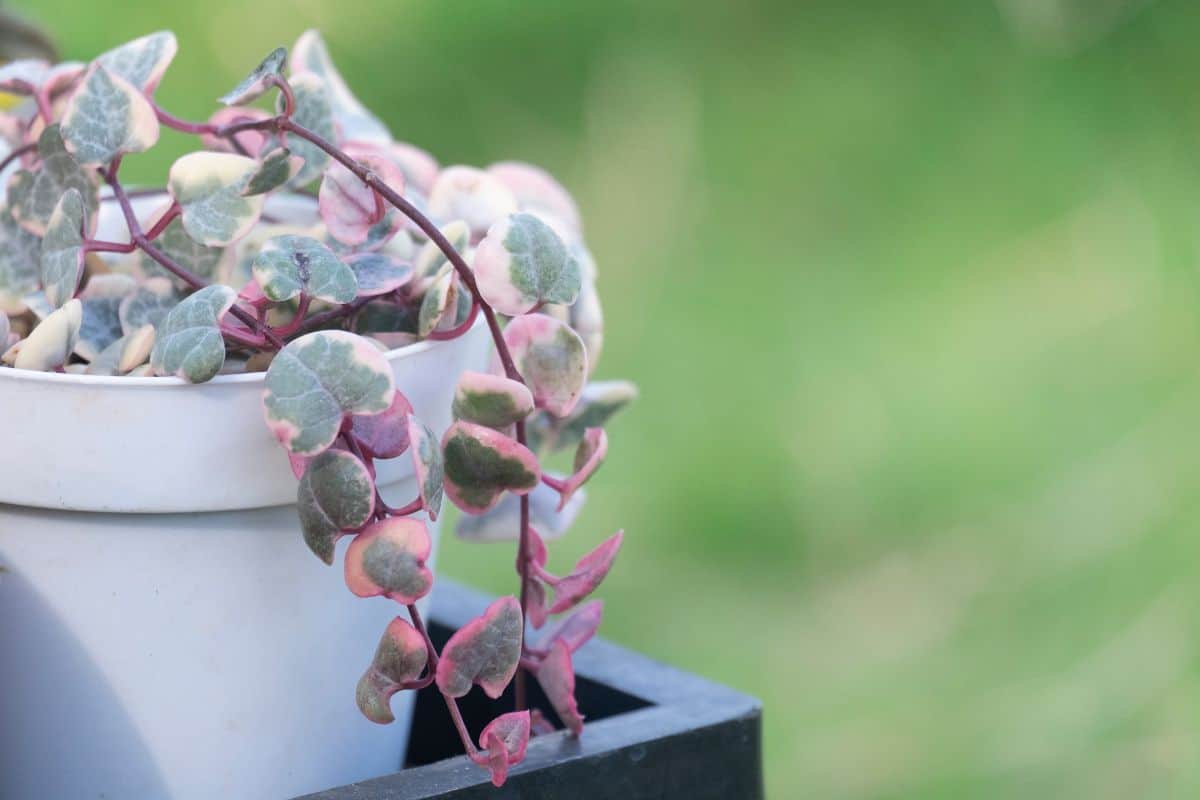A string of hearts (Ceropegia woodii or Sweetheart vine, Chain of hearts, Rosary vine) is a wonderful choice for decorating a room due to its easy care and magical appearance. Having figured out how to repot string of hearts, it will delight you for many years.
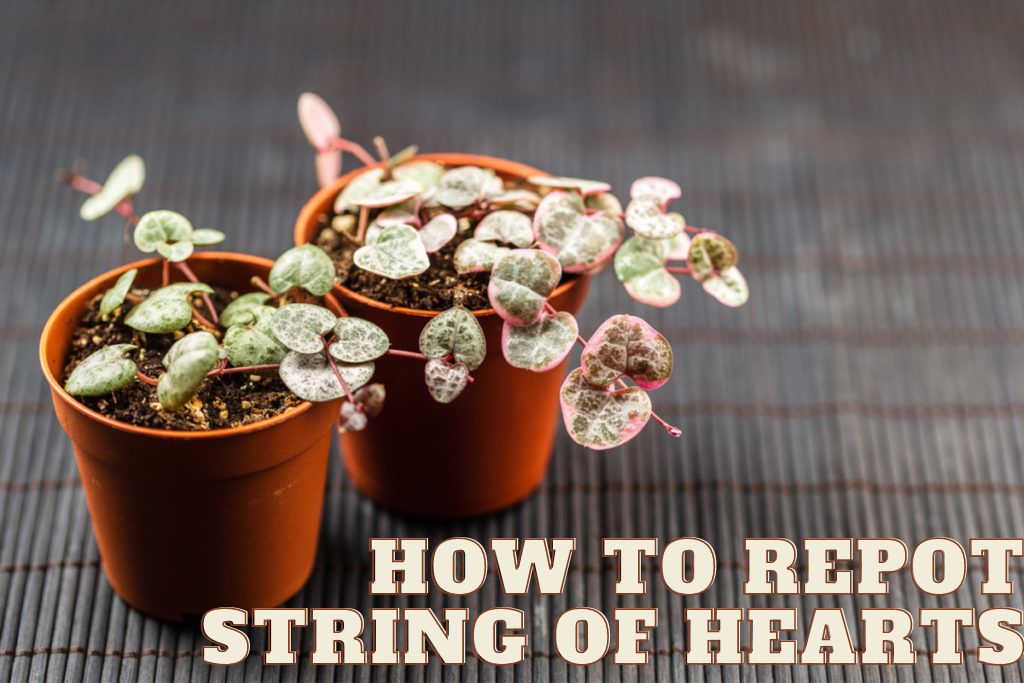
This evergreen succulent trailing vine is native to South Africa, Swaziland, and Zimbabwe. This must be taken into account in order to choose the right care for the string of hearts. Sunny and hot Africa has taught the String of Hearts to enough light and little watering, so in room conditions try to give it a lot of direct sunlight, especially after transplantation.
Is it necessary to repot string of hearts, and how often is it necessary?
The string of hearts likes to be root bound, so don’t rush to repot your plant unless it’s clearly necessary. Some experts recommend transplanting the string of hearts every 1 or 2 years. It is worth focusing on the appearance of the string of hearts, its growth rate, and tillering.

Please note: in not enough light conditions, the plant may become paler, not as dense, and begin to grow slowly.
The optimal time for transplantation is considered to be spring and summer, and spring is the time of the plant’s vegetation when the green mass is actively multiplied. In order for the string of hearts to take root better, all dry or unhealthy roots should be cut off.
Watering is also recommended to be reduced for a while. Over-watering can cause root rot before the string of hearts has stabilized in the fresh potting soil.
Your hearts plants definitely need to be repotted if the roots are growing out of the drainage holes, the green mass seems too dense, and the soil dries out much earlier than usual.
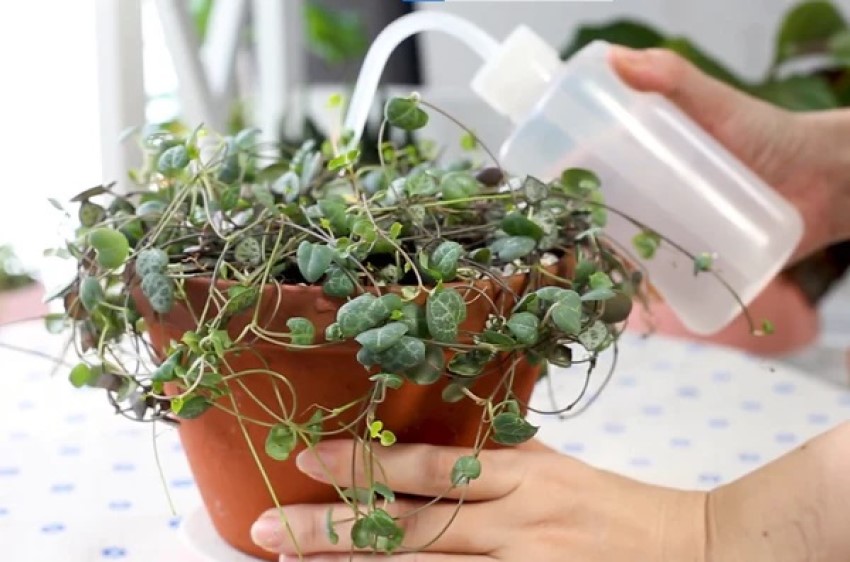
What’s the best type of pot for a String of Hearts?
The transplant pot you choose should be slightly larger than the previous one to ensure the best growth of the heart string.
However, do not use too large a transplant pot, as this hearts plant does best when the roots are limited. Many indoor gardeners use the principle of choosing a pot one size larger than the previous one during the string of hearts transplantation.
The pot must have a drainage hole, or even several. Note that porous pots such as terracotta will allow the soil to dry out more quickly, while plastic pots are good at retaining moisture. Drainage holes in pots allow excess moisture to drain out of the soil, so take care of a decorative pot or stand to avoid messy drips.
What soil does String of Hearts like?
We have already figured out that the string of hearts is a succulent and does not like waterlogging. Therefore, any well-draining soil can be used as soil.
You can use soil for succulents or cactus mix with the addition of pumice/perlite and coarse sand. Flower growers recommend using 2-3 parts of the soil mixture for 1 part of the pumice.
How does it work? Pumice stone improves the aeration and drainage of the potting mix. This means that the roots of the string of hearts will have a better supply of oxygen and will not rot. Pumice should be chosen as homogeneous and sifted.
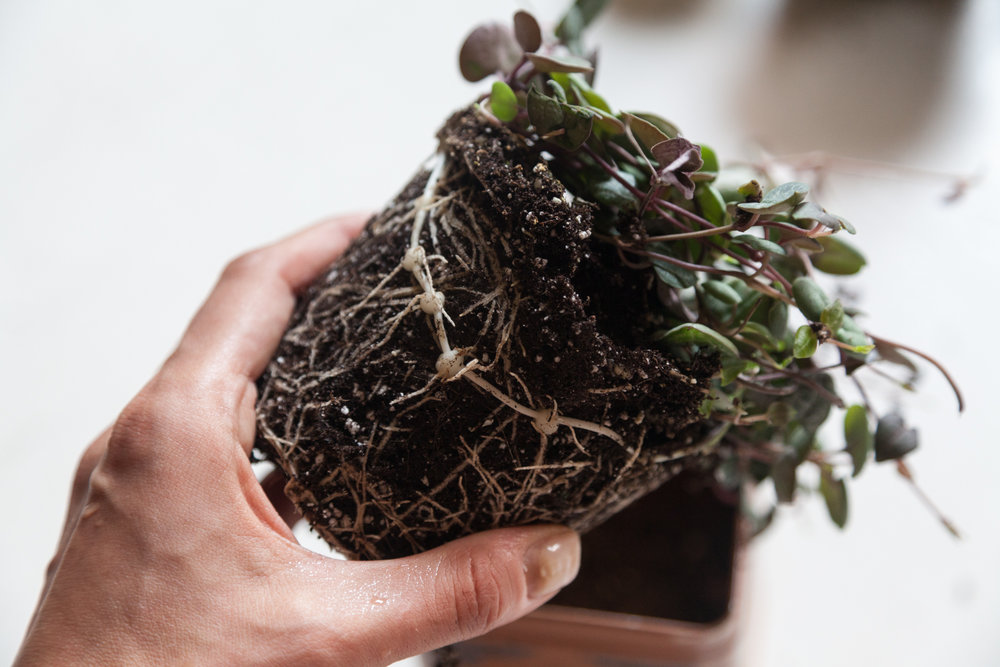
It will be helpful to add activated charcoal to the potting mix during transplanting the heart string to prevent root rot.
Activated carbon is a highly porous material that effectively absorbs excess water. Added activated charcoal to your flower pot forms an effective barrier between water and your hearts plant’s delicate roots.
Some recommend more complex mixes, such as equal parts coco coir, succulent potting mix, charcoal, and orchid bark. You can also often find worm castings and compost in mixtures. However, we must remember that succulents are very stress-resistant plants, so the rational option would be to use any well-drained soil.
In the axils of old leaf blades, small tuberous outgrowths form, which play a role in the accumulation and preservation of moisture. Thanks to these growths and tuberous thickening of the roots, the hearts plant can do without water for a long time, even in drought.
Tips: how to transplant hearts plant
Fill a new pot with drainage holes with soil mix in the proportions indicated above. Moisten the well draining potting mix, but don’t overdo it!
Lay the string of hearts on its side and carefully remove it from the old pot. If you decide to transplant a pot with several hearts plants, this is a good reason to give each heart plant its own capacity for further growth.
If the hearts plant is in a plastic container, squeeze the perimeter of the container and carefully remove the root system of your heart chain. If the string of hearts is in a hard container, run a knife around the inside of the pot to make it easier to remove.

Fluffing the root ball. Don’t skip this step. You will increase the area of accessibility of the root system, which will help your hearts plant get used to a new place faster. Before transplanting, make sure that the roots of your string of hearts are not dry. After removing the hearts plant from the old pot, pull up and separate the roots, and fluff them up.
If the roots have grown together into a tight ball, and you find it difficult to fluff it with your hands – take a sharp knife and make several vertical cuts (1-2 inches long) in the bottom and sides of the ball.
It sounds strange as you are intentionally damaging the string of hearts, but this will help the heart chain develop new roots where it is cut and adapt more quickly.

Gently place the roots of the string of hearts in the new soil and lightly press the soil around them.
You should not water the plant, as you moisten the soil immediately before transplanting. Water the string of hearts only when the potting medium is dry.
Tuber as a potential plant
Surely, if you have been growing the string of hearts for more than a year, you have noticed that the string of hearts forms tubers along the vines. Each tuber that comes into contact with the ground can grow into a new plant.
Therefore, monitor the density of the root system by removing tubers or transplanting them into a separate pot and getting a new plant from the mother plant.
Read also: how to repot orchids with air roots: a step-by-step guide, useful advice.
How to transplant tubers into a new pot
You can put the tubers along with the vines on the ground in a new pot. Tubers can be partially buried. Roots will grow from the tuber over time; when the string of hearts takes root, the tuber can be removed.
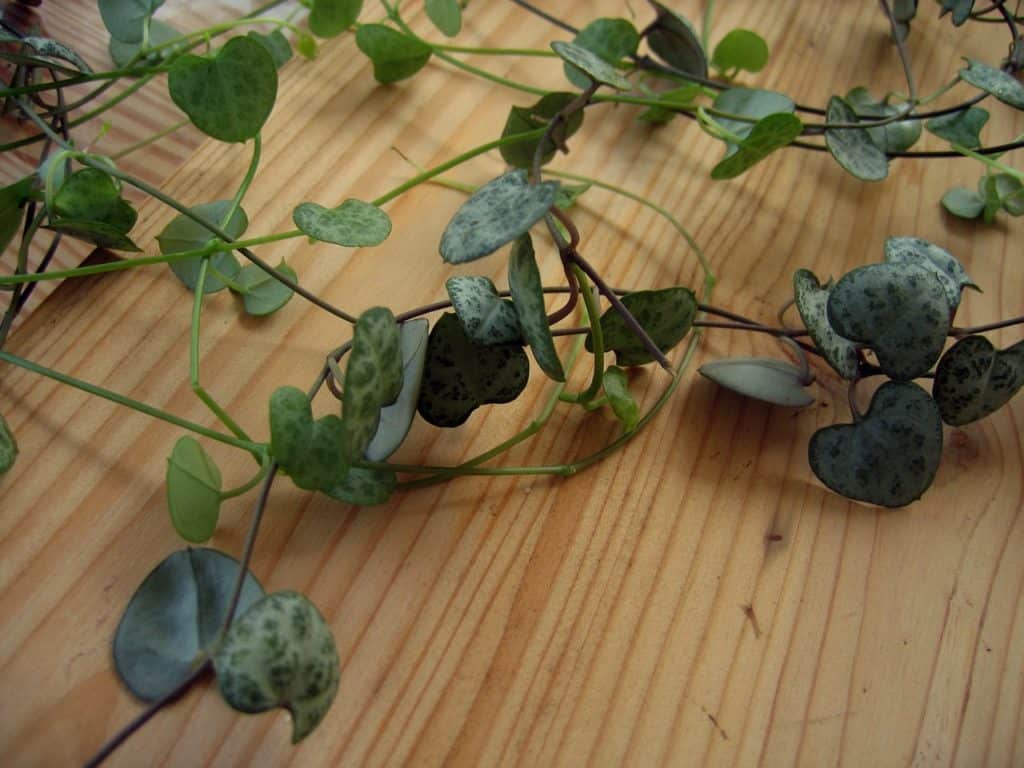
Advice
If you have an old plant with a bare base, you can increase its density by transplanting it into a pot with young tuber vines.
Planting cuttings plants in a pot will also help to increase the density after transplanting
To do this, take a few stem cuttings of plants a few inches long and place them in water. To avoid rot and standing water, remove the leaves from the part of the cuttings that are submerged in water. However, it is still recommended to keep a few leaves.
One or two nodes of the plant should be under water – this is the place where the leaf meets the stem. It is from this place that the roots of a young plant will grow. The more cuttings, the better. Change the water at least once a week. The place should be well lit, then you will notice the first roots in a couple of weeks.
Roots half an inch long are a sign that cuttings should be planted in the ground with the main plant.
You can improve on this method of increasing plant density with cuttings by laying them horizontally on top of the rooting soil.
Be careful!
You need direct contact of the stem node with the ground. You can even artificially create this contact by securing the cuttings with paper clips.
In order for cuttings to take root faster, you need to increase the humidity.
Place the container or pot of live bait in a clear plastic bag and close it. Open the bag every couple of days to remove excess moisture and prevent mold.
Density at the expense of length in indirect light conditions
You can also increase the density of the transplanted plant by wrapping hanging vines around the surface of the soil and pressing them down with paper clips.
Keep the soil slightly damp to encourage rooting. The pot can also be placed in a transparent plastic bag, which should be exposed to bright, indirect light.
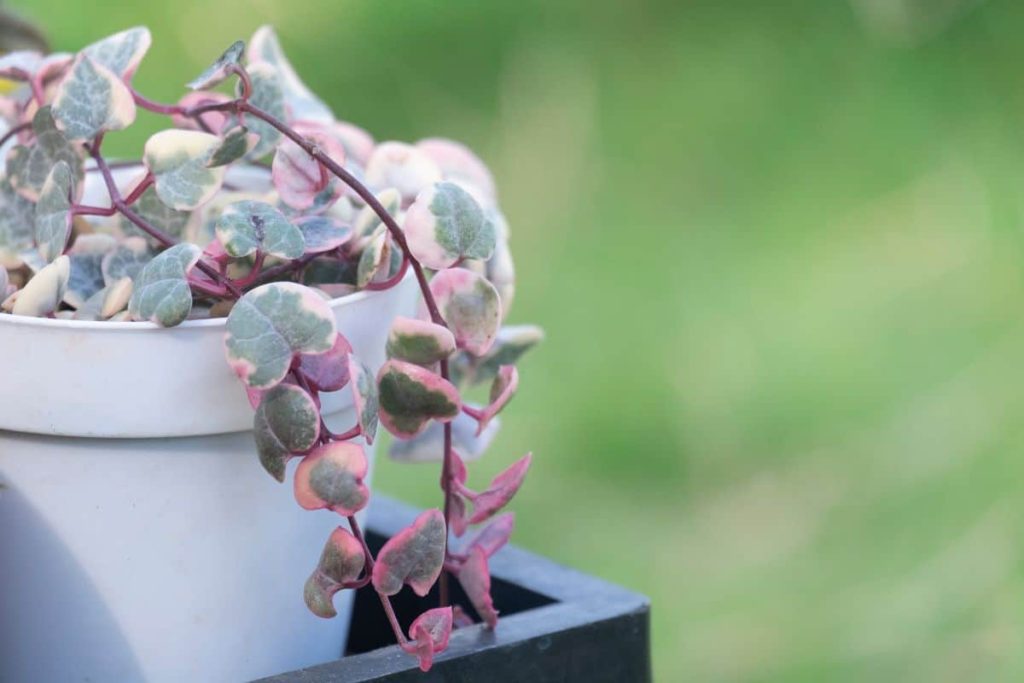
Read also: Healthy orchid roots
When the cuttings have taken root, remove the plant from the bag and place or hang the pot in a well-lit area, preferably on the south side of the room.
Conclusion
In this article, we examined in detail the aspects of transplanting the string of hearts and figured out how to choose the right soil and pot for transplanting.
We hope that your plant will take root safely in a new place and will delight you with young shoots.
Do string of hearts need big pots?
No, string of hearts (Ceropegia woodii) does not need a big pot. They can be grown in small, shallow pots, as long as the pot has good drainage and the soil is well-draining. Over-potting can lead to water-logging and root rot, so it is best to choose a pot that is only slightly larger than the root system.
What soil do string of hearts use?
String of Hearts (Ceropegia woodii) grows best in a well-draining, light potting mix, such as a cactus or succulent mix, or a mix of regular potting soil, perlite, and sand. The soil should allow excess water to drain quickly to prevent root rot.
How do you transplant a string of hearts plant?
To transplant a string of hearts plant: prepare well-draining potting mix, remove from current pot, cut off damaged stems, place in new pot, fill with mix, water thoroughly, place in bright light, keep soil moist.

